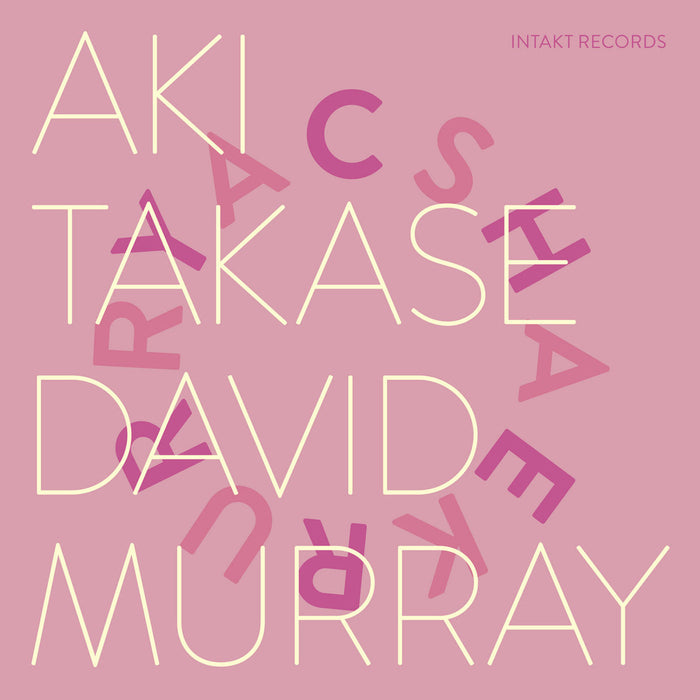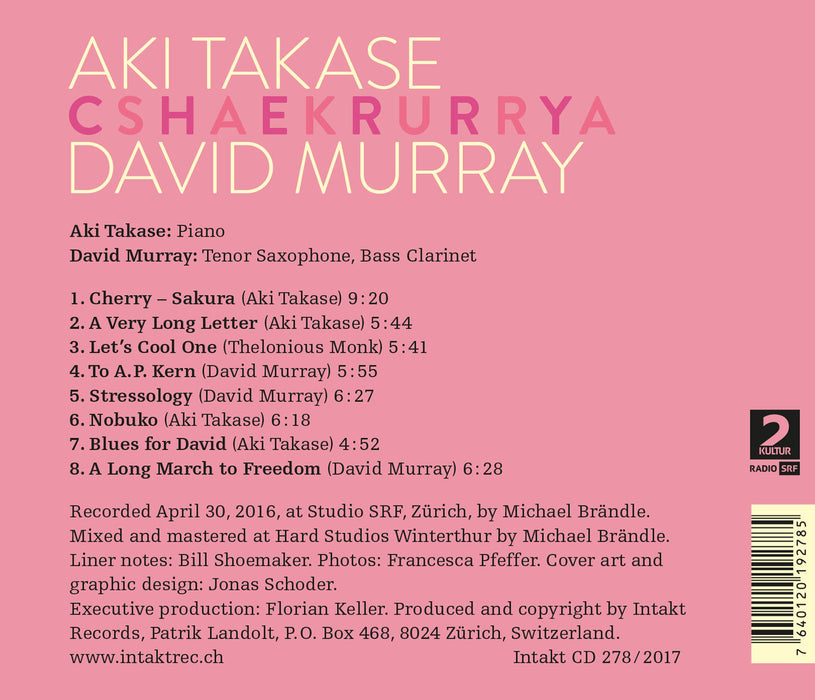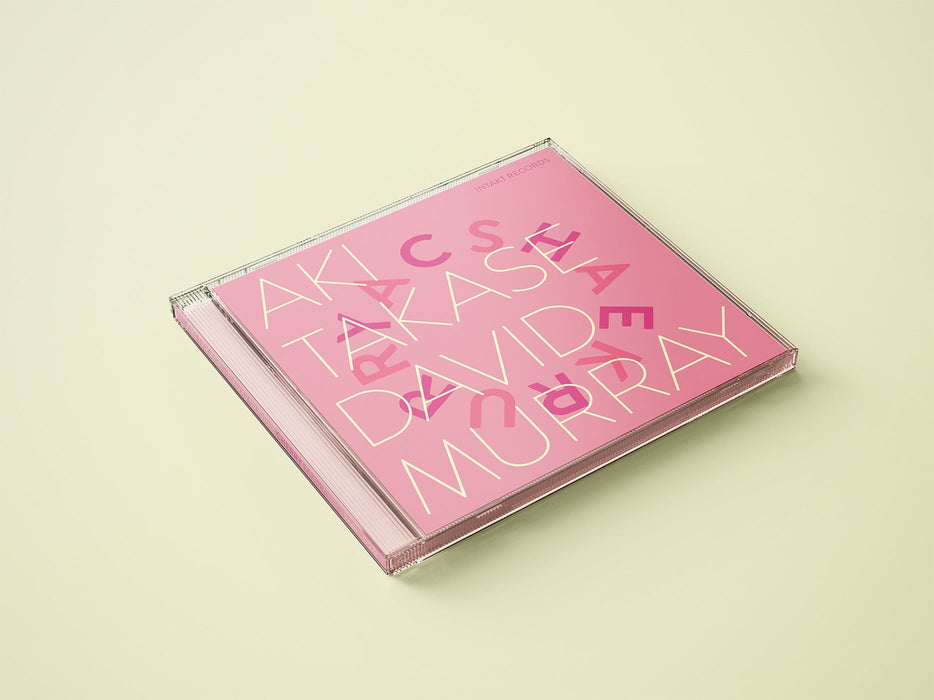


278: AKI TAKASE – DAVID MURRAY. Cherry - Sekura
Intakt Recording #278/ 2017
Aki Takase: Piano
David Murray: Tenor Saxophone, Bcl
More Info
Im Laufe der Jahre haben Aki Takase und David Murray eine vorzeigbare Anzahl herzergreifender Kompositionen kreiert, von denen einige, die dem Prozess der Reife ganz besonders verpflichtet sind, nun auf der CD «Cherry - Sakura» zu hören sind. Im Vergleich zum früheren Album ermöglichen sie nicht nur eine andere Form des musikalischen Dialogs, sondern auch eine profundere. «Cherry - Sakura» ist ein wunderbares Gespräch über die grossen Lebensfragen von zwei Künstlern, die in ihrem Leben bereits alles zumindest einmal erfahren haben. Um einen veralteten Jazzspruch wiederzubeleben, Takase und Murray sagen etwas mit diesem Album. In einem Satz: Reife ist alles. (aus den Linernotes von Bill Shoemaker)
Album Credits
Cover art and graphic design: Jonas Schoder
Liner notes: Bill Shoemaker
Photos: Francesca Pfeffer
Recorded April 30, 2016, at Studio SRF, Zürich, by Michael Brändli. Mixed and mastered at Hard Studios Winterthur by Michael Brändli.
Spennende samtaler
Den japanske pianisten Aki Takase og den amerikanske tenorsaksofonisten og bassklarinettisten David Murray har funnet hverandre igjen etter over 20 års opphold. Aki Takase og David Murray har mye å fortelle oss – og hverandre.
Musikk for meg er ofte sammenliknbart med samtaler. Takase (70 ) og Murray (63) fant tonen på alle vis for nesten 25 år siden da de spilte inn «Blue Monk». Når har de plukka opp igjen tråden som om om det var i går og «Cherry – Sakura» har blitt nok en samtale av høy byrd.
De to kommer fra forskjellige tradisjoner – Takase med sin japanske bakgrunn og så frijazzbevegelsen i Europa. Hun har bodd i Berlin i mange tiår og er gift med en annen pianist i avantgardismens elitedivisjon, Alexander von Schlippenbach. Murray hører hjemme i den amerikanske tradisjonen med både modernisme og masse blues i seg.
Til troass for dette så har altså de to funnet det nyttig og spennende å utfordre hverandre – eller kanskje akkurat derfor. Denne gangen møttes de på halvveien, i Zürich i Sveits. Murray er nå nemlig bosatt i Portugal. Repertoaret er også bortimot 50/50 – de har skrevet halvparten hver pluss at de tolker forbildet Thelonious Monks "Let´s Cool One".
De to fører uten unntak meningsfulle og originale samtaler basert på sine enorme referanser. Det er ikke vanskelig å høre at Murray, som også var en del av World Saxophone Quartet, har en sterk tilknytning til alt og alle fra Ben Webster og Coleman Hawkins til Albert Ayler og John Coltrane, mens Takase bidrar med alt fra sin japanske oppvekst til Monk og enda friere toneganger.
Til sammen har det blitt et nytt, flott og tidløst møte med to strålende og originale musikanter.
https://torhammero.blogg.no/1525114416_spennende_samtaler.html
Twenty three years after their first studio date Blue Monk (Enja, 1993), Japanese pianist Aki Takase and American saxophonist David Murray reunite in Switzerland. There has been one live recording since, Valencia (Sound Hills, 1997), but the question remains what took them so long? The saxophone/piano axis has been a favored format for both. Murray's companions include Mal Waldron, John Hicks, Randy Weston and most frequently Dave Burrell, while Takase's partners encompass Rudi Mahall, Silke Eberhard, Louis Sclavis and Daniele D'Agaro. The attraction of the barebones set-up is obvious in the starkly lit stage and direct communication it affords.
The program of four by Takase, three by Murray and a lone interpretation of Monk contains a lovely mix of the bracing and the beautiful, which in a way sums up both their playing. Takase combines hints of tradition and modernity into a personal but appealing mélange. Murray displays a breathy full tone with just the occasional acerbic twist, deployed in a blend of dashes and suspensions which keep the listener guessing as to where he will end up. He also gives his accustomed control of the upper registers a thorough airing, though he does so in such a way that it enhances the emotional charge.
Half the pieces are tributes of one sort or another and they engender empathy by the barrel load. The ravishing title track gets the album off to a searing start, part mantra and part lament, before opening for Murray's tumbling tenor over Takase's rippling chords. Both take an unaccompanied break, Murray ascending into finely wrought falsetto, Takase edging towards dissonance, before a tender theme restatement which nonetheless takes some tangential liberties. That establishes the template, where the two take conventional roles, time and melody usually near at hand.
Of the other dedications, they swaddle Murray's "To A.P. Kern" in rich harmonies and murmuring Ben Webster-isms, while Takase's "Nobuko" is another gorgeous hymnal, bittersweet with traces of joy, in honor of her late mother and her "Blues For David" comes across as wryly affectionate. Elsewhere "A Very Long Letter" begins choppy and tense as Murray's agitated jostling cuts across the pianist's line, but after a bout of muscular piano introspection they end in jaunty unison. A similar breathless quality pervades "Stressology" where Murray hits the stratosphere. Perhaps unsurprisingly they are at their most playful on a sprightly "Let's Cool One," enlivened by Murray's insouciant bass clarinet. Two old hands in full command.
https://www.allaboutjazz.com/cherry--sakura-aki-takase-intakt-records-review-by-john-sharpe
Het is iets meer dan twee decennia geleden dat pianiste Aki Takase en saxofonist David Murray ‘Blue Monk’ uitbrachten. Nadien ging eenieder zijn eigen weg om zoveel jaar later opnieuw samen de studio in te duiken.
Deze keer geen openlijke ode aan Monk. Toch staat er nog een Monk-compositie op het repertoire, namelijk ‘Let’s Cool One’. Meteen een speelse duik in de jazzgeschiedenis toen pianisten nog stille films begeleidden. Aansluitend is er het zwoele en bluesy ‘To A.P.Kern’ met Murray in pure Ben Webster-stijl. Kenmerkend voor het hele album trouwens het uiterst hoog toegankelijkheidsgehalte. Niets mis mee natuurlijk want ook titels als ‘Nobuko’, ‘Blues For David’ en zelfs ‘A Long March For Freedom’ bieden genoeg kanttekeningen om te blijven luisteren naar wat deze twee elkaar toevertrouwen.
Wie hen eerder verkiest op het scherp van de snede, opteert voor de twee eerste nummers en het epileptisch funky ‘Stressology’ waarin beiden om beurt elkaar ophitsen met meer snedige uithalen.
Duidelijk een plaat van twee artiesten die heel wat watertjes doorzwommen maar niet **** uitpakken met elk hun trukendoos. Integendeel, ze doseren op een ongelooflijke manier. Voor diehard fans van het extremere werk misschien net wat te evenwichtig. Toch durven we te hopen dat ze geen 23 jaar meer wachten om nog eens een duo-cd op te nemen.
http://www.jazzenzo.nl/?e=3738
Parmi les habitués du label, la pianiste d’origine japonaise Aki Takase : son dernier album, « Cherry Sakura », un duo passionnant avec David Murray. Chacun a une longue expérience du duo : un gage de complicité. Retour à la tradition avec Let’s Cool One de Monk (joué à la clarinette basse), un blues (Blues for David), des thèmes en forme d’hymnes (A Long March to Freedom), des tempos survoltés avec envolées du ténor et déluges de notes du piano. Aki Takase a aussi enregistré d’autres duos : avec Louis Sclavis (« Yokohama »), Han Bennink (« Two For Two »), le clarinettiste Rudi Mahall (« Evergreen »), le pianiste Alexander von Schlippenbach (« Iron Wedding ») ou la violoniste Ayumi Paul (« Hotel Zauberberg »). En solo, elle a aussi enregistré « My Ellington ».
http://jazzaroundmag.com/?p=16219
Un dialogo iniziato oltre vent'anni fa, quello tra Aki Takase e David Murray, quando incisero Blue Monk, un album dedicato alle composizioni di Thelonious Monk. Il pianista di Rocky Mount, nume tutelare della tradizione non allineata del jazz moderno, ritorna anche in questo Cherry—Sakura, che include una bella versione di "Let's Cool One." A parte questo brano, l'unico non originale, il disco è (quasi) equamente diviso tra composizioni di Takase (quattro) e Murray (tre).
Vale la pena partire proprio da "Let's Cool One," dove Takase trova subito il giusto equilibrio tra supporto armonico e divagazioni ritmiche, a sostegno di un Murray scatenato al clarinetto basso, che coniuga agilità tecnica e incisività timbrica, senza mai perdere di vista le coordinate melodiche della composizione.
Questo brano è in qualche modo emblematico dell'approccio condiviso dai due musicisti, che lungo tutto il disco dimostrano non solo rispetto, ma soprattutto un sincero affetto per la tradizione del jazz, muovendosi prevalentemente nei confini di un mainstream di livello assoluto, con qualche sporadica sortita in territori più avventurosi.
I brani più originali in questo senso sono quelli di Takase, che dimostra una capacità di scrittura inusuale—dall'escursione frenetica di "A Very Long Letter" al tempo sospeso di "Cherry—Sakura" e alle atmosfere dolenti di "Nobuko"—riuscendo a fornire qualche spunto inaspettato pur tenendo ben presenti le regole del jazz più classico.
Le composizioni di Murray sono in qualche modo più prevedibili, anche se sempre efficaci, e a ben vedere incarnano perfettamente un'idea musicale che è rimasta costante nella lunga carriera del sassofonista: abbracciare senza preconcetti le diverse "tradizioni" del jazz, e scardinarle in qualche modo dall'interno, grazie a idee chiare e un talento strumentale smisurato, tuttora evidente.
È sempre un piacere ascoltare due maestri all'opera, soprattutto se, come in questo caso, oltre che sulle capacità tecniche e il proverbiale interplay, l'intesa si fonda sulla concezione condivisa della tradizione jazz come campo di ricerca aperto, dove anche i confini stilistici più rigorosi permettono di trovare sempre, in qualche modo, qualcosa di nuovo da dire.
https://www.allaboutjazz.com/cherry-sakura-aki-takase-intakt-records-review-by-nicola-negri
The vast experience that Takase and Murray have as duet players is heard from the opening bars of the lengthy title track. It is a heavenly melody invested with an emotional depth to match technical mastery, as the long, langoruous tones ease into life like breath itself before gliding gently through the changes with great poise. To the credit of both performers there is very little superfluous activity on this and other pieces in the set, and the moments in which the duo breaks to a solo horn from Murray or solo piano from Takase do not fall prey to hyperbole in the face of solitude. Murray has a sensitivity as an accompanist that belies his reputation as a fearsome one-man whirlwind, and while he does launch some turbulent flights of fancy, which are duly matched by Takase's equally fiery comping, this is a deeply reflective album, pitched between sunlit romanticism and sombre melancholia. At times the spirit of Fats Waller's 'Jitterbug Waltz', recast as a corps in four rather than three, pervades the music, while at others the power of gospel, expertly nuanced by the players, illuminates the themes, none more so than the majestic 'A Long March To Freedom'. It feels very much of yesterday and today.
In 1991, the pianist and tenor saxophonist recorded the duo album Blue Monk, followed later by Valencia. Thelonious Monk is a huge inspiration for Takase, so it's no surprise to find one of his compositions here - a jaunty "Let's Cool One", in the master's stride- style spirit, with Murray on bass clarinet. Otherwise, the programme alternates originals by the pair, both fertile composers. Murray has commented that he sees his music as being the "new standards", but as with other contemporary jazz composers, sadly the jazz community resists taking them up. Takase's poignant, anthem-like title track was inspired by an Ango Sakaguchi short story. "To AP Kern" is one of Murray's sumptuous ballads for tenor saxophone, with unaccompanied cadenza; "Nobuko", with its melody drawing on Romantic pianism, is a tribute to Takase's recently deceased mother.
After a ho-hum opener and a congested free-for-all joust, the music suddenly awakens with Murray's droll bass clarinet on Monk and gets even better from there. A likely high in a high-flying career. -John McDonough
Wise rhythmic variations and an inspired choice of moods help keep this duet album a balanced affair, but I feel like Murray's impressive fireworks are becoming rote at this point. -Jim Macnie
From Takase's deliriously beautiful opening track, "Cherry," to Murray's inspiring manifesto, "A Long March To Freedom," these duets showcase two free improvisers with a deep sense of tradition deeply in sync. -Paul de Barros
Duets are so revealing. They require the utmost attention from two musicians-either in support or in discussion, entwined or independent. Playing with another person means playing solo and support simultaneously, and when it works well, it can be absolute magic.
Japanese pianist Aki Takase, long a Berlin resident, has been on a roll with great duets for Intakt, but this one might be the best yet.
She and reedist David Murray have instant rapport, a kind of innate connectedness that seems related to a shared respect for form and controlled volubility. Murray is at the top of his game. I've not heard a more fulsome and becoming recording from him in a long while; it's nice and close, but rich and full toned.
Throughout, Murray is hand-in-glove with Takase's sensitive harmonic playing, nowhere more dramatically than on the pianist's "Blues For David," where she puts down lush and surprising chords. And when Murray plays bass clarinet on a very laid-back take on Thelonious Monk's "Let's Cool One," the pianist offers abstracted stride moves in support.
The title track is an achingly elegant, slowly unfolding song with folk overtones drawn out gorgeously by Murray's tenor. Likewise, the saxophonist's dedication "To A.P. Kern," for the 19th-century Russian memoirist, is a bittersweet ballad, each of the musicians reaching for ways to touch a nerve. In terms of the interplay, the duets of Archie Shepp and Horace Parlan come to mind. But Murray and Takase seem a more adventurous pairing, taking more liberties and more solo space.
It's hard to ask for much more than what the duo of pianist Aki Takase and reed player David Murray provides. Each in their own way is unafraid of pushing at the edges of jazz but neither is beholden to such efforts. They share a forward-looking traditionalism, a passion for past masters, without wanting to go back in time. But what perhaps defines the duo most is the warmth and fullness of their playing. The natural voices of Takase's piano and Murray's tenor saxophone and bass clarinet are pushed to capacity without being allowed to break. There are passages on their new album where it's staggering how much music-not noise, not sound, but in-the-pocket melody and harmony-two people can make.
Their only other album together is 1993's Blue Monk, where they matched four of Thelonious Monk's tunes with some of their own and a few standards. They use a different strategy here, playing four of Takase's pieces and three of Murray's alongside Monk's "Let's Cool One", strategically positioned in the first half of the program. Murray states the bouncing theme on bass clarinet before Takase provides a slow stride accompaniment. It's a few joyful moments in an album that isn't melodramatic but for the most part has more serious concerns. Takase dedicates pieces to Murray ("Blues for David") and in one of the album's most gorgeous melodies-to her recently departed mother. Murray references his own "Stressology" and "A Long March to Freedom", as well as the dedicatee of an Aleksandr Pushkin poem. It's not a dark album but certainly isn't frivolous.
It would be best at this point in time to refrain from thinking about all the records we could have had from this duo over the past 23 years and just be glad that, at last, we have another.










